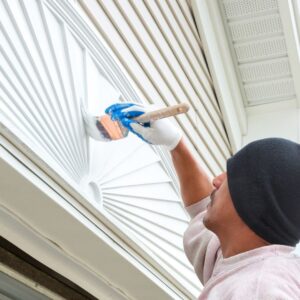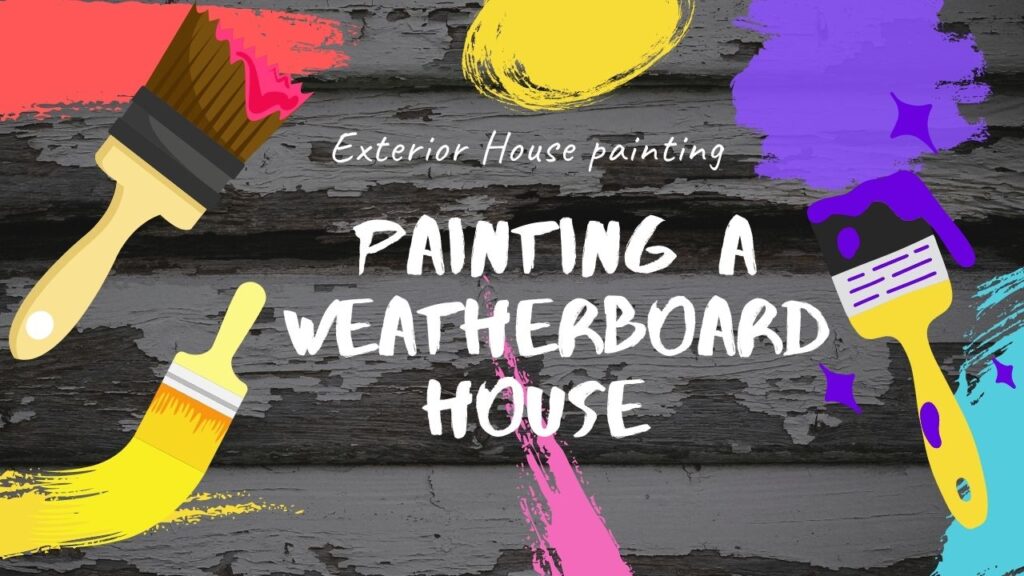What Are Weatherboards?
Painting weatherboard houses are the main type of exterior painting we do in Brisbane. Weatherboards are a type of cladding that is commonly used to cover the exterior of a building to look attractive and protect the building.
Traditional weatherboards are made of wood or reconstituted hardwood that can be painted or stained to your choice.
Modern weatherboards are made of vinyl and come already coloured.
Nothing beats the look of wood weatherboards, but be aware that they require constant maintenance to keep them looking their best (repainting, re-staining or re-sealing every few years, etc.).
Vinyl weatherboards are available in various colours and moulded to look like wood without the associated maintenance.
They are low maintenance and just requires a regular wash down with a mild detergent and water.
Another type of cladding is made of fibre cement. Fibre cement weatherboards are resistant to moisture, rot, termites and fire when adequately maintained. These can also be painted.
Use Of Weatherboard Cladding
Weatherboards are ideal for cladding the home’s exterior and can be attached to all types of substrates, including fibre cement, brick and so on.
You can choose to clad the entire house with weatherboards, or you can combine them with other building materials such as brick, plaster, stone and even wood to create a massive range of designs.
Weatherboard panels are available in a variety of profiles to match homes that are traditional or modern. Weatherboard panels are quick and easy to install on any home, and they are lightweight yet sturdy.
Weatherboards will last a long time if installed and maintained correctly.
Advantages Of Using Weatherboards
They have lower initial construction costs compared to masonry homes. The reason is weatherboard panels are readily available at a low price. They can also be made from reclaimed wood, making them an environmentally friendly option.
Weatherboards provide good insulation in the Brisbane weather conditions because air is trapped between the boards, regulating heat or cold. Because we do not get too cold this is fine in the winter months.
It is easier to install or build a home with weatherboards, and the construction time is relatively short because not all the work needs to be done by professionals. With a good plan, anyone with basic carpentry skills can build a house of Weatherboard.
It is easy to make repairs to weatherboards. However, these repairs are often loose nails or a rare filling in a rotten piece of wood, which takes a short time to repair.
In addition, unlike brick structures, weatherboards are more tolerant of earth movements such as minor earth tremors than brick homes.
How Often Should I Paint My House’s Exterior?
There is no correct answer for the most common question we get asked, “How often should I paint my house’s exterior?”
Instead, the solution is based on various factors, including the following:
– The climate in your area.
– The type of cladding on your home.
– The quality of paint that was previously used.
Homeowners often don’t paint the exterior of their home as often as they should because they don’t pay close attention. If the house’s colour and siding/cladding look good from a distance, they assume everything is fine.
It may be, but you can’t tell for sure until you take a closer look:
– If peeling and cracking window trim is visible from a distance, it’s a sign that you should have repainted your trim last year or the year before and definitely shouldn’t put it off until next year.
– If you have wood boards, you should inspect them closely every year or two.
Pay particular attention to areas where the wood overlaps or abuts other materials. In these areas, look for the mark of moisture, termite infestations or mould.
– Weatherboards doesn’t need to be painted as often as wood but don’t neglect siding, window trim, doors and other woodwork.
Painting A Weatherboard Facade
Weatherboard is synonymous with many classic Australian home styles – from coastal homes to the traditional “Queenslander.” But, like other aspects of a home, a weatherboard still requires maintenance and protection to keep it looking fantastic and keeping the weatherboards in good condition.
So if your weatherboard home is looking a little dull and flaky, a fresh coat of paint is the most effective way to rejuvenate your home’s exterior.
Surface Preparation Is Key
Before you begin the task of painting the outside of your home, there are a few things you should check.
– Is there anything you need to fix first?
– Rotten weatherboards, windows, doors? Are other things going to cause problems like damaged gutters?
– Rusty metal doors/window parts/nail heads, sand them down first, then paint with metal primer.
– Prime the bleeding knots in weatherboards first.
– Nails that need to be re-set. Use a nail punch, sand prime, and trowel over.
– Removing old paint:
If it’s peeling – get rid of it!
Scrape off peeling paint. Sand all surfaces smooth, including weatherboards!
Sanding is essential, not only to get a better finish but also to get better adhesion between coats.
Your paint will last much longer if you sand everything and have the surface smooth.
– Prime all bare wood.
Take the worry out of painting weatherboards and help you achieve a perfect paint finish on what is often considered one of the most challenging materials to paint.
Here are tips from weatherboard painting experts so you can tackle your DIY exterior project like a pro.
A Step-By-Step Guide To Painting Weatherboards
These hints will help you achieve the perfect paint job for your weatherboard home.
1. Surface Preparation
Pressure washing will is a fast and effective way to clean your exterior and make sure your surfaces are free of dirt and peeling paint.
Alternatively, you can use a scrubber and scrub those surfaces with a bucket of water.
If you are repainting older weatherboards, sand off any old paint, dirt, grit or other debris by hand to ensure a smooth surface each time.
2. Tackle The Wall In Sections
Before you start applying the first coat, it’s crucial to have the right brush on hand.
Use a good quality brush to sweep each board’s bottom into each overlap before continuing with even brush strokes.
Instead of painting one long horizontal movement at a time, divide your wall into sections.
Take advantage of natural breaks in weatherboards (such as corners, windows or doors) to minimize movement as you complete the project.
This way, you’ll avoid vertical gaps between sections and achieve an even finish as the paint dries.
3. Work from top to bottom
Start painting from the top and paint three boards simultaneously, starting in one corner and working your way to the opposite side.
If you start this process from the top-down, make sure you don’t stain any fresh coats of paint in the lower areas by working directly over them.
4. Allow Drying Time Between Coats Of Paint
Always allow at least two hours of drying time!
Check the can to see how many coats are required for each colour, as darker colours may require more coats.

Expert Tips For Exterior Weatherboard Painting
-How many coats of paint should you typically apply?
You should apply two coats of paint to the exterior of your home. However, if the surface is bare, untreated wood or wood with a high tannin content may require a primer, so three coats may be necessary.
It is always advised to check the product label to see if a primer is needed.
-Why is it so important to test the paint colours first?
It is imperative to test the paints first because they may appear different at different times due to the light reflection on the surface. Different times of the day will give different results.
So make sure you check the colour in the morning, midday and late afternoon so you can see the true representation of the colour
Buy sample pots to paint a small area so you can step back and observe the colour in all lighting conditions.
What Are The Most Common Exterior Colours?
Some of the most popular and common exterior colours are
Star White, Black Ace, Arctic Crossing, Silver Treasure, Salt and Sand and Rhino Grey.
Can You Apply Paint With A Paint Roller?
We can use paint rollers on weatherboards. A smaller roller will help you get to those hard-to-reach areas on the exterior of your home. However, if you are painting a large room and have a good quality brush, you will get a better result than using a roller for a large area.
Not Wanting To Paint A Weatherboard Home Yourself?
You are not alone!!
Even though it is relatively straightforward, the preparation can be lengthy. You may not have the time or inclination to tackle this painting project on the weekend or after work.
Painting hard to reach areas will require safety ladders and platforms to work on.
Face it = serious injuries from falls off ladders are the main emergency department injuries every weekend.
Hiring a professional painting team to do your exterior painting will ensure that the weatherboard painting project will take less time.
Contracting a professional painter from Brisbane Painting Pros will ensure to take care of every exterior painting project. From the detailed prep work to the top-notch painting application to the thorough cleanup at the end of the project. They have professional painters with over twenty-five years of experience.
Best of luck with painting your weatherboard house!!
The post Painting Weatherboard Houses By Exterior Painters appeared first on Emergency Squad.
The Article Painting Weatherboard Houses By Exterior Painters First Appeared ON
: https://gqcentral.co.uk


